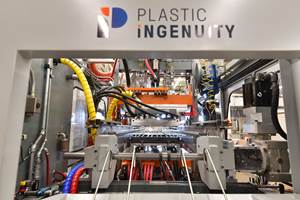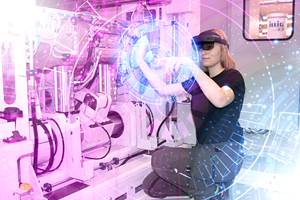Processors' Wish List: What's Your Million-Dollar Dream?
How would you spend a windfall of $10,000, $100,000, or $1 million added to your operating budget? Here’s what owners and managers of plastics plants said they would do with this dream cash.
Plastics Technology asked its readers to daydream on the job. “What would you do if you suddenly found an unexpected $10,000 in your operating budget?” we asked. “What if it were $100,000 or $1 million?” We wanted to know what piece of hardware or software were they hankering for? What gadget or plant improvement or staff enhancement would they invest in if only they could afford to?
We collected answers from 55 firms. The respondents were primarily presidents and owners of businesses, but they also included plant managers, senior engineers, and department heads.
Upgrading existing plants and machinery was at the top of their wish lists. Expanding capacity or manufacturing space was a close second. Take a closer look at their fantasies and see how they would compare with yours.
Who’s dreaming?
The 55 respondents to our survey include 17 company presidents or owners; seven vice presidents, general managers, and plant managers; 12 engineers; 11 department heads; and eight supervisors. Among the 55 processing companies represented are 34 injection molders, 22 extruders, six thermoformers, three compounders, two compression molders, two rotomolders, and one blow molder. (Some perform more than one process.)
Overall, 37% of the respondents say they would spend a cash windfall to upgrade existing equipment, 31% would add new machines, 24% wish for more land or a new building, and 8% want to invest in their employees. The remaining 27% have other priorities, ranging from test labs to an S Class Mercedes Benz.
Some owners of struggling businesses would reserve the windfall as a cash cushion for operations. The owner of one small company that extrudes plastic tubes writes simply that he would use it to pay off bills. Another processor says he would spend his dream cash to build up a raw-material inventory. He wishes he could afford to keep adequate material on hand, “so we’re not constantly working hand to mouth when we get an order.” A Michigan automotive molder would invest his $10,000 in spare parts to reduce maintenance downtime.
In the $10,000 dream category, respondents most frequently wish they could automate materials and product handling. With bigger windfalls of $100,000 and $1 million, they imagine replacing worn old machines with spanking new ones. Another significant priority is to buy lab equipment, especially small-scale processing machines for new product development.
A handful of respondents dream not of nuts and bolts, but of upgrading employee’s skills, safety, and comfort. Their wish lists include training programs for machine operators and outside seminars for salespeople and managers.
Auxiliaries are big
Processors of all types say they want to upgrade their auxiliary equipment, particularly materials handling and storage. On their $10,000 wish lists, injection molders want new dryers, grinders, weigh blenders, and in-line color mixing. In downstream auxiliaries, they want sprue pickers and conveyor systems for parts and runners. Several molders would love to replace old chillers with new mold-temperature controllers that can both heat and cool. And one processor rhapsodizes about his gravimetric blenders and wishes he could buy more of them: “They have contributed more to our bottom line per capital dollar spent than any other expenditure.”
With an imaginary $100,000 at their disposal, 30% of injection molders still dream of improvements to material handling, as do 12% of extrusion processors. Cooling and heating systems also appear on $100,000 wish lists. One large molder in Wisconsin would chuck a 20-year-old cooling tower and replace it with modern mold-temperature controls—and spend the rest on SPC software and QC equipment.
Others want central vacuum loading or individual hopper loaders and gravimetric feeders to replace volumetric types. They also want more automation tools like six-axis robots, custom degating systems, and vision systems to check molds for inserts or stuck parts.
Dream machines
If they had an extra $1 million to spend, more than half of the injection molders surveyed would buy brand-new machines, while 25% would put it toward a new plant or land. Molders hanker especially for those energy-efficient all-electric presses.
Bigger injection molders also dream of things like clean rooms and ISO-9000 quality-certification programs. A senior manufacturing engineer at a large injection molder of electrical parts would invest his $1 million in silos and improved facility layout.
Eighty percent of extrusion processors would buy new machines if they had a million bucks. They salivate over the idea of “a bright, shiny new extruder with all the latest auxiliaries and controls,” as one put it.
Extrusion processors wish they had $10,000 to buy material-handling extras like static-removal equipment, gravity dedusters, and continuous gravimetric blenders. A large blown film processor in Texas would buy a computer for tensile testing. Another blown film extruder would like “a software package to keep track of screws, barrels, gearboxes, etc.” And blown film producers that make bags wish for things like new bag cutters and to upgrade from two- to four-color printing.
With a spare $100,000 on hand, extrusion processors would organize more efficient material storage and add edge-trim reclaim and bag houses for dust recovery.
For $10,000, extrusion compounders dream of lab testing equipment like melt indexers, impact testers, and capillary rheometers. A maker of concentrates would buy a gaylord dumper and vacuum loading system. A single-screw compounder wished for one or two of the newer mixing-screw designs: “I would like to evaluate whether they help us with color mixing and melt homogeneity.”
If they had $1 million, several compounders say they would change from batch to continuous processing to improve consistency and reduce scrap.
With a spare $100,000 on hand, extrusion processors would organize more efficient material storage and add edge-trim reclaim and bag houses for dust recovery.
Thermoformers would be happy to invest in more machines, as well as in new CNC trimmers. They would also like digitizers to help them design molds faster from patterns. A few thermoformers dream of buying an injection molding machine to make thin-wall packaging. On the flip side, several injection molders wish for some spare cash to invest in thermoforming machinery.
The product manager of a small rotomolder of fuel tanks in Iowa has his eye on a different set of priorities. With $10,000 he would “remodel the employee bathroom and break room and promote safety through more warning signs.” With $100,000 to spend, he would finish the interior of the company’s three buildings, a total of 7000 sq ft. And for $1 million he would build one 15,000-sq-ft building to house the business more efficiently.
The one blow molder in the survey is the business manager of a large midwestern medical-parts producer. In the $10,000 dream category, he wants shop-floor monitoring software to help identify and reduce waste and downtime. For $100,000, he would buy gravimetric color feeders to replace volumetric ones. For $1 million, he would like to get into molding some different kinds of parts.
Human assets come first
Some 18% of all respondents would like extra funds to upgrade their staffs. One company president who wants to spend part of his windfall on his employees heads a small automotive injection molding firm in Indiana. He writes that he “went through two years of declining business, and many people have stuck with us.” He would spend a cash windfall of $10,000 in overdue bonuses for his workers, who have had no raise recently. With $100,000, he would pay $10,000 in bonuses, and with the remainder he would buy new grinders, chillers, and hopper loaders. With $1 million, he would do all of the above plus replace an older press with a new one.
Injection molding managers in our survey are far likelier than extrusion managers to think of spending money on training or other benefits for their workers. With $10,000, a production engineer at an Alabama automotive molder would “train operators and managers to learn how to reduce mistakes and achieve better discipline.” With $100,000 he would buy more operator training “plus training for mechanics.” And with $1 million, he would buy all of the above, plus refurbish some machines.
The plant manager of an injection molding and extrusion processor in Michigan writes that if he had an extra $1 million (or owned the business), he would air-condition the entire plant. “The summer in Michigan can get so hot it takes your breath away, and installing AC would be a godsend for my employees,” he explains.
The manufacturing manager of an electrical-parts molder in Iowa says he puts upgrading people ahead of equipment because his company already has top-quality new machinery. So he would invest $10,000 in computerized training programs and would “buy ice-cream bars for the entire company.” With $100,000 he would cross-train operators on different jobs and convert to quicker mold-changing methods. And with $1 million he would buy back-up molds for three-quarters of the company’s tools, train operators to make better use of the sophisticated controls on their machines, and with whatever is left would “buy ice cream bars all around for a complete week.”
One of processors’ favorite daydreams is of replacing older worn-out machines with bright, shiny new ones loaded with all the latest bells and whistles. High on nearly everyone’s wish list arefundsto upgrade and automate material handling.
Beyond nuts-and-bolts fantasies, some managers would invest their windfall in training or other benefits for their employees. One manager would buy ice cream for all his workers for a week.
Related Content
US Merchants Makes its Mark in Injection Molding
In less than a decade in injection molding, US Merchants has acquired hundreds of machines spread across facilities in California, Texas, Virginia and Arizona, with even more growth coming.
Read MoreIngenuity Is Part of This Former’s Name, and in Its DNA
Plastic Ingenuity started in a garage in 1972 and through a commitment to developing best-in-class products stands today as one of the largest custom thermoformers in the world.
Read MoreEnhanced Digitization in Thermoforming
Illig’s Easy product family includes the newly developed Human Machine Interface, Illig Easy Touch.
Read MoreThermoformer Maximizes Productivity with 3D Printing
Productive Plastics has created an extensive collection of 3D printed manufacturing aids that sharply reduce lead times.
Read MoreRead Next
How Polymer Melts in Single-Screw Extruders
Understanding how polymer melts in a single-screw extruder could help you optimize your screw design to eliminate defect-causing solid polymer fragments.
Read MoreLead the Conversation, Change the Conversation
Coverage of single-use plastics can be both misleading and demoralizing. Here are 10 tips for changing the perception of the plastics industry at your company and in your community.
Read More










.png;maxWidth=300;quality=90)
















